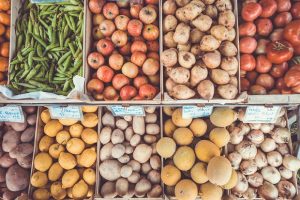With kilometres of shelves of supermarket choices to stock our pantries and fill our bellies how do we make sure that we’re investing in nourishing food? Every second package is smothered in promises of being good for you but is it really? If longevity is on your wish list for the years ahead, looking after your health must be your highest priority. If you’ve always wanted to learn another language, we’ll get you started with how to translate food labels.
Fresh is always best
The 1975 BBC television series The Good Life made many of us want to dig up our yards and grow our own produce. The idea of being self-sufficient is a great IDEA but not all of us have the know-how or time to make it happen.
Sourcing foods straight from a grower or producer and knowing how they grow and produce their food is the next best way to ensure you’re getting optimal nutritional value. Farmers markets are a great way to build out a weekly menu that is also an investment in your wellness. Our number one tip is that the closer your food source is to where it originally came from, the better the health benefits for you.
But fresh isn’t always possible. Not all of us are budding chefs. Most of us need a little help and some time saving shortcuts.
How to discover what is under glossy food packaging
Fortunately we live in a time and country where our policy makers do invest in health regulations. In the simplest terms if a food is packaged, the Australia New Zealand Food Standards Code enforces standards around what must be included on the food label. There are a number of exemptions. For the purpose of this article, we’re just talking about supermarket shelf, fridge or freezer products.
A food label has to include, the name:
- of the food and the percentage of the key ingredient
- and business address of the importer and manufacturer
- of the country the food came from.
And:
- a list of ingredients
- warnings about allergens, even if there may only be traces left over from packaging
- a nutritional information panel
- a use by date or best before date.
What’s the difference between a use by date and a best before date?
This question pops up a lot. A use by date is where a food is perishable and will not be safe to eat after a specified date. A best before date is where the shelf life of the food is less than two years.
How to read an ingredients listing on a food label to make healthy food choices
The most important consideration in looking at the ingredients listing is that the ingredients are listed based on weight. The ingredient that weighs the most in the package you’ve bought is listed first, the second heaviest ingredient by weight second and so on. So if you’re buying frozen crumbed fish and bread crumbs are listed as the first ingredient – you’re not going to get much fish!
Additives are a necessary evil of mass consumer food goods, but not always. Some foods are unnecessarily loaded with additives and preservatives that are not good for anyone.
Additives and numbers to avoid
Additives are classified by code numbers. According to Choice Magazine, the additives to be wary of include code ranges:
- 100: these are colourings that add or restore colour
- 200: preservatives that slow down deterioration of food by micro-organisms
- 300: anti-oxidants that slow down or stop oxidisation of foods
- 600: flavour enhancers
- 900: artificial sweeteners
- 420: bulk sweeteners like sorbitol
These additives have been linked to a number of adverse health and behavioural outcomes.
Ignore packaging hype. Go straight to the Nutrition Information Panel
Claims of low sodium, low sugar or low fat don’t mean a lot on their own. Don’t let two or three word tag lines entice you. Always head straight to the Nutrition Information Panel and know what you’re looking for. Here are some guidelines from Diabetes Australia:
- Low fat: look for less than 5g total fat per 100g, and ideally less than 3g per 100g.
- Low salt: look for less than 400mg sodium per 100g.
- High in fibre: look for more than 3g dietary fibre per 100g.
- Fat free: look for 0.15g of fat per 100g or less.
Low cholesterol doesn’t always mean low fat. Always refer back to the Nutrition Information Panel and the total fat per 100g number.
No added sugar or no added salt does not mean the food is sugar or salt free – check the Nutrition Information Panel.

‘Per 100g’ not ‘Per serving’ when translating a food label
Avoid the column that states ‘Per serving’ as being an accurate guide. Often the ‘per serving’ size is on the bare minimum side. Always use the ‘Per 100g’. That way you’re always comparing apples with apples (pardon the pun)!
After all that research and claims of false claims, it is off to the Farmers Market for this writer I think!
Helpful resources and references
Choice Magazine > Food additives you should avoid
Australian and New Zealand Food Standards > Additives
Diabetes Australia > Reading food labels
Healthy Weight Wee > Understanding food labels




